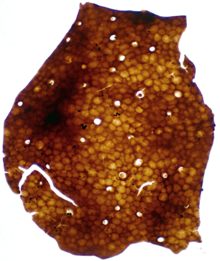| Cosmochlaina Temporal range:
| |
|---|---|

| |
| Cuticle of Cosmochlaina, retrieved from the Burgsvik beds by acid maceration. Cells about 12 μm in diameter. | |
| Scientific classification | |
| Kingdom: | Plantae (?) |
| Phylum: | "Nematophyta" |
| Class: | †Nematophytina |
| Order: | †Nematophytales |
| Family: | †Nematothalaceae Strother 1993 |
| Genus: | †Cosmochlaina Edwards 1986 |
| Species | |
| |
Cosmochlaina (from Greek: kosmos=ornament; xlaina=wrapper/cloak) is a form genus of nematophyte – an early (Silurian – Devonian) plant known only from fossil cuticles,[1] often found in association with tubular structures.[2] The form genus was put forwards by Dianne Edwards, and is diagnosed by inwards-pointing flanges and randomly oriented pseudo-cellular units.[3] Projections on the outer surface are always present, and sometimes also appear on the inner surface; however, the surface of the cuticle itself is always smooth.[3] The holes in the cuticle are often covered by round flaps, loosely attached along a side.[3]
Where Nematothallus was sometimes used to relate only to tube-like structures, Cosmochlaina was used in reference to the cuticle fragments. Material discovered later revealed its internal anatomy, which comprises a lichen-like mat of 'hyphae'.[4]
It has been suggested that the pores of Cosmochlaina represent broken-off rhizoids, on the basis that rotting and acid treatment of extant liverworts produces a similar perforated texture.[5] However, the status of this form genus in any one kingdom is not secure; members could, for example, represent arthropod cuticle.[6] Alternatively, different species may in fact represent different parts of the same organism.[3] Based on the more recent material, a lichen affinity seems most plausible.[7]
- ^ Kenrick, P.; Crane, P.R. (1997). "The origin and early evolution of plants on land". Nature. 389 (6646): 33–39. Bibcode:1997Natur.389...33K. doi:10.1038/37918. S2CID 3866183.
- ^ Gensel, P.G.; Johnson, N.G.; Strother, P.K. (1990). "Early Land Plant Debris (Hooker's" Waifs and Strays"?)". PALAIOS. 5 (6): 520–547. Bibcode:1990Palai...5..520G. doi:10.2307/3514860. JSTOR 3514860.
- ^ a b c d Edwards, D. (1986). "Dispersed cuticles of putative non-vascular plants from the Lower Devonian of Britain". Botanical Journal of the Linnean Society. 93 (3): 259–275. doi:10.1111/j.1095-8339.1982.tb01025.x.
- ^ Edwards, Dianne; Axe, Lindsey; Honegger, Rosmarie (2013). "Contributions to the diversity in cryptogamic covers in the mid-Palaeozoic:Nematothallusrevisited" (PDF). Botanical Journal of the Linnean Society. 173 (4): 505–534. doi:10.1111/boj.12119.
- ^ Graham, L.E.; Wilcox, L.W.; Cook, M.E.; Gensel, P.G. (2004). "Resistant tissues of modern marchantioid liverworts resemble enigmatic Early Paleozoic microfossils". Proceedings of the National Academy of Sciences. 101 (30): 11025–11029. Bibcode:2004PNAS..10111025G. doi:10.1073/pnas.0400484101. PMC 503736. PMID 15263095.
- ^ Taylor, T.N. (1988). "The Origin of Land Plants: Some Answers, More Questions". Taxon. 37 (4): 805–833. doi:10.2307/1222087. JSTOR 1222087.
- ^ Edwards, Dianne; Axe, Lindsey; Honegger, Rosmarie (2013). "Contributions to the diversity in cryptogamic covers in the mid-Palaeozoic:Nematothallusrevisited" (PDF). Botanical Journal of the Linnean Society. 173 (4): 505–534. doi:10.1111/boj.12119.